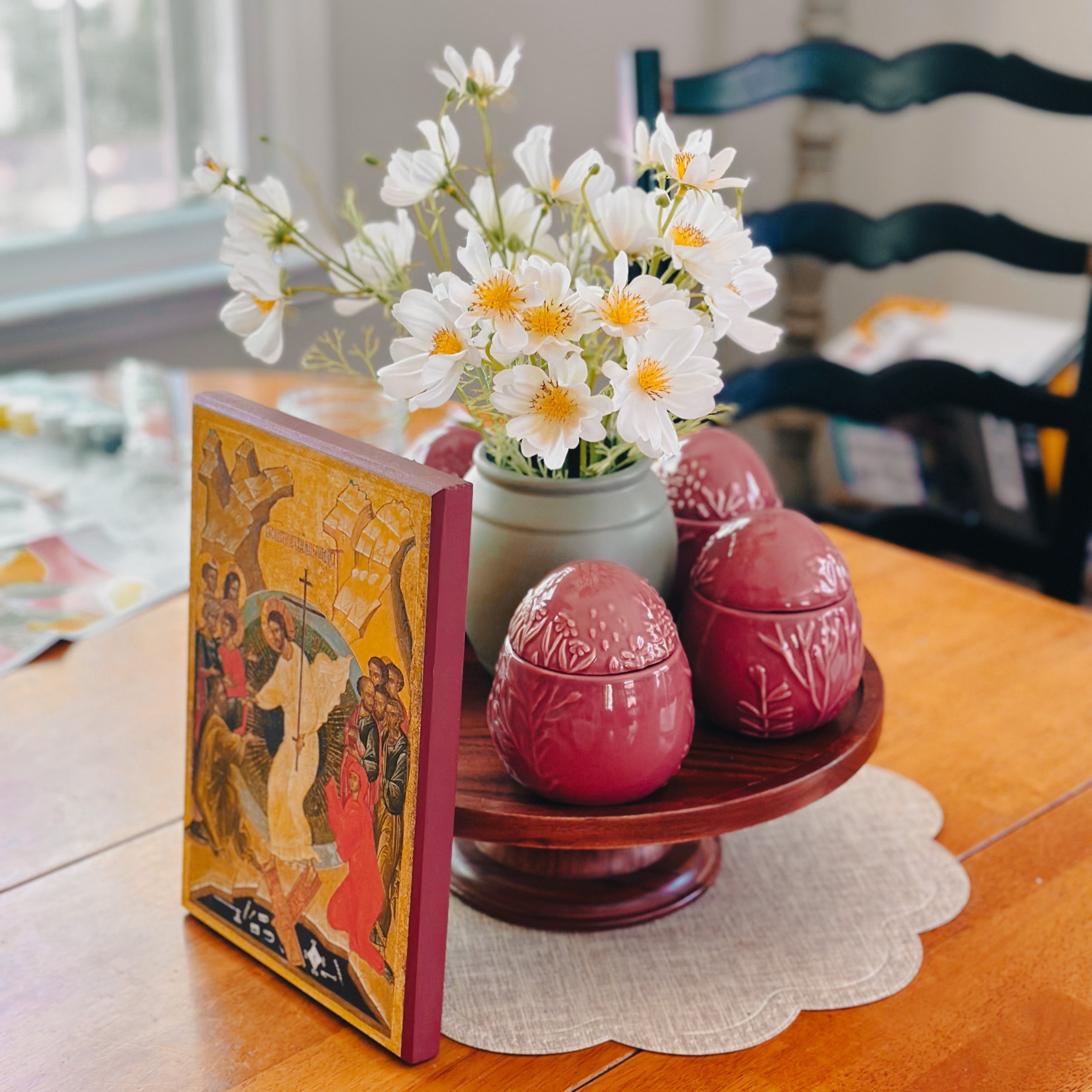Dyeing Red Eggs Naturally
One of my favorite parts of Holy Week preparation is dyeing red eggs which is an important tradition in the Orthodox Church. Some of the memories I carry with me each year: the warmth of the kitchen, my children’s delightful squeals as they watch the eggs turn a bright, vibrant red, and the joy we feel a we shine the eggs. Each time we make them, I am in awe of the little miracle of transforming white eggs to a bright red using onion skins. But did you know these red eggs hold meaning—they symbolize the blood of Christ, His resurrection, and the joy of new life? In this blogpost, I want to share not only how we dye our eggs using natural ingredients, but explain why this tradition means so much to me and to so many Orthodox families around the world.
Scroll down for the recipe to make red eggs with natural ingredients
Do you know the story behind the red egg?
It’s said that after Jesus’ resurrection, Mary Magdalene went to Tiberius Caesar proclaiming Jesus raised from the dead! Unmoved, he replied that there was as much chance of a human being returning to life as there was for the egg he was holding to turn red. Immediately, the egg miraculously turned red in his hand!
Mary Magdalene was one of the Myrrh-bearing women, who went to anoint the body of the buried Christ. She was the first messenger sent by the Lord Himself to announce His resurrection (Mark 16:1-10). In the icon of St Mary Magdalene, you'll see her holding a red egg. It’s said that eggs were first dyed red at Pascha by Christians in Mesopotamia, perhaps as early as the second or third century. From there, the tradition spread to Greece and then throughout the Christian world.
These red eggs are typically given out to the faithful after the midnight Pascha service. It’s a small reminder to us of the miracle of Christ raising from the dead. The original “Easter Egg” so to speak. These traditions have a rich history and meaning. Isn’t it interesting to see where these modern practices began? It all circles back to Holy Tradition preserved in the Orthodox Church!
When do you dye your eggs red?
Typically during Holy Week, as time allows. In the Greek tradition, Holy Thursday is the day designated to dye red eggs. The red color is symbolic of Christ’s blood, and since Holy Thursday evening’s service (which is done in anticipation of Friday) is the day when Jesus is nailed to the cross, many choose to dye their eggs on this day. It is customary to provide red eggs for the faithful, which is then distributed after the Paschal Liturgy. If you’d like to try your hand at making them this year, I promise it’s not very complicated. I’ve made them every year for the past 5 years and I have yet to mess it up!
Yellow Onion Skin Natural Method
If you’re wanting a natural way to dye eggs, try the onion skin method! You’ll need the papery skin of about 10-12 brown/yellow onions to make this happen. Some people collect onion skins throughout lent, but if you’ve forgotten, go to your local grocery store and ask if you can take some of the papery onion skins left around the onions in the produce aisle. They may look at you funny, but I’m sure they won’t mind you cleaning up for them a bit! Also, see note below about the NEW kit available from Legacy Icons.

Red Pascha Eggs
Make traditional red eggs for Pascha using onion skins and vinegar. These natural ingredients are safe, non-toxic, and they make eggs that are a beautiful deep rich red. And the best part is it won't stain your hands!
Ingredients
- 12 brown (or white) eggs
- A gallon of dark brown papery skin from yellow onions
- 1 tbsp vinegar
- Olive Oil for polishing (optional)
- Parsley leaves
- Womens nylons
Instructions
- Put your onion skins in a large stainless steel pot.
- Fill the pot with water. Push the onion skins down into the water so that they’re wet and not floating on top of the water. Note, use metal or plastic spoons or else they will stain.
- Bring the water to a rolling boil, then turn the heat down to a simmer and cover the pot.
- Simmer for 30 minutes.
- Remove the kettle from the heat and let it stand until it reaches room temperature.
- While the dye is cooling, take your eggs out of the refrigerator and let them come to room temperature.
- Pour the dye through a mesh strainer into a large bowl or another kettle. Discard the onion skins.
- (optional) If you'd like to make decorative eggs, place a parsley leaf flat on the raw eggs and wrap it with a women's nylon. Tie it up the ends and cut the excess.
- Place your clean, uncracked, raw, room-temperature eggs in a single layer in the pot.
- Pour the room-temperature dye over the eggs. Make sure the eggs are covered with at least two inches of the dye solution.
- Add a tablespoon of vinegar to the water.
- Gently bring the eggs to a boil. Let the eggs boil for one minute, then put a lid on the pan and take the pan off the heat. Let the eggs sit, with the pan covered, until they’re cool. The eggs will cook completely as they sit. Approximately 30 mins.
- Check the color of the eggs. If it’s not deep enough red to suit you, put the pan with the dye and eggs in the refrigerator overnight.
- Take the eggs out of the dye and let them dry on a rack.
- When they are completely dry, polish the red eggs with a soft cloth or paper towel and a little bit of olive oil.
- Bring them to Church to be blessed!
Notes
* You can save onion skins all year. Keep them in a zip-top plastic bag in the cabinet or freezer. A gallon bag full of onion skins makes plenty of dye for a batch of eggs. If you didn’t save the skins, just ask the folks at the produce department at your local grocery if they’ll give you a bag of onion skins.
*Don't use a porous pot to boil the dye as it will stain.
Nutrition Facts
Calories
200Fat
6 gSat. Fat
2 gCarbs
30 gFiber
5 gNet carbs
24 gSugar
14 gProtein
9 gSodium
75 mgCholesterol
164 mgWatch this reel on how I make these eggs on Instagram:
Why Natural Red Egg Dye?
There are many different dyes on the market to make vibrant red eggs. I personally prefer the natural method, for various reasons, but one of the main reasons is it doesn’t leave a red residue on your hands, and it’s completely non-toxic, so you won’t need to worry about anything toxic leaking into your egg! I also feel like it’s more likely the way people have been dying them for a few thousand years, so that part excites me too!
Decorative eggs using parsley leaves and nylons.
Watch this reel on Instagram to make the decorative version:
Natural Onion Skin Red Egg Dye Kit:
Last year was the first time using the natural onion skin red egg kit by Legacy Icons. It was so simple and required absolutely no prep. The clean up was even easier! I love that the bag is made from unbleached 100% cotton cheesecloth bag. And the best part? The bag and recipe card can all be composted and recycled because the ingredients are all natural. This eco-friendly opinion is exactly what I have been hoping for for years and I'm so thankful Legacy Icons is offering this now! Check them out for all your prayer corner supply needs!
Natural Red Onion Dye Kit - I tried this kit this year and I was sooo impressed with how simple and easy it was. 10/10 would recommend. In fact, watch my tutorial on instagram HERE where I filmed making the red eggs using this kit. You can find this kit exclusively at Legacy Icons! Enjoy 15% off your order with coupon code ALM15 at checkout! You can find it HERE.
**They have a single batch size (the one I’m using) and a larger kit for churches that can dye up to 4 dozen eggs.
Little Miracle
The whole process took about an hour and the eggs were a bright/deep red. Once we polish our eggs with a little bit of olive oil, they are absolutely stunning! It always feels like a little miracle watching these white eggs turn bright red using just onion skins, vinegar and water!
Watch this reel on how I put together a traditional Pascha basket!
Bring your eggs to Church in your traditional Pascha basket, or adorn your Paschal table with these luscious red eggs! Whatever you do, I pray it’s a blessing to you and your family!













